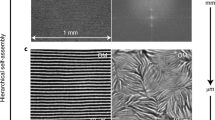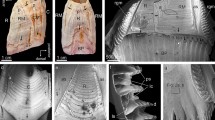Abstract
ORGANISMS such as diatoms and radiolaria synthesize elaborate biomineral exoskeletons which display hierarchical structures patterned on length scales from less than a micrometre to millimetres. Synthetic materials chemistry, in contrast, has traditionally been able to achieve regular patterning only on microscopic (<10 Å) and more recently1–3 mesoscopic (10–103 Å) length scales. Here we report the synthesis of crystalline, lamellar aluminophosphate structures that are patterned on the submicrometre-to-millimetre scales found in the living world. As in the syntheses of ordered mesoporous solids1–3, our approach involves templating by self-assembled organic aggregates, and we propose that the larger scale of the patterning here arises from the involvement of vesicle templates rather than the micelle-like or bilayer structures thought to be responsible for mesoscale pattern formation1–3.
This is a preview of subscription content, access via your institution
Access options
Subscribe to this journal
Receive 51 print issues and online access
$199.00 per year
only $3.90 per issue
Buy this article
- Purchase on Springer Link
- Instant access to full article PDF
Prices may be subject to local taxes which are calculated during checkout
Similar content being viewed by others
References
Kresge, C. T. et al. Nature 359, 710–712 (1992).
Beck, J. S. et al. J. Am. chem. Soc. 114, 10834–10843 (1992).
Monnier, A. et al. Science 261, 1299–1303 (1993).
Kaler, E. W. & Martino, A. Langmuir 11, 779–784 (1995).
Thomas, B. N., Safinya, C. R., Plano, R. J. & Clark, N. A. Science 267, 1635–1638 (1995).
Israelachvili, J. N. Intermolecular and Surface Forces 2nd edn (Academic, New York, 1991).
Hoffmann, H. Adv. Mater. 6, 116–129 (1994).
Haslop, W. P., Allonby, J. M., Akred, B. J. & Messenger, E. T. US Patent No. 4,618,446 (1986).
Akred, B. J., Messenger, E. T. & Nicholson, W. J. US Patent no. 4,659,497 (1987).
Fendler, J. H., Membrane Mimetic Chemistry (Wiley, New York, 1982).
Oliver, S. et al. Stud. Surf. Sci. Catal. 84, 219–225 (1994).
Simkiss, K. & Wilbur, K. M. Biomineralization: Cell Biology and Mineral Deposition (Academic, San Diego, 1989).
Mann, S., Webb, J. & Williams, R. (eds) Biomineralization: Chemical and Biochemical Per-spectives (VCH, New York, 1989).
Takahashi, K. (ed) Radiolaria (Ocean Biocoenosis Ser. no. 3, Woods Hole Oceanographic Institution, Woods Hole, MA, 1991).
Richard, M. (ed.) Ouvrage Dedie a la Memoire du Professor Henry Germain (Koeltz Scientific, Konigstein, 1990).
Anderson, O. R. Radiolaria (Springer, New York, 1983).
Mann, S. J, mater. Chem. 5, 935–946 (1995).
Oliver S. & Ozin, G. A. Adv. Mater. (in the press).
Author information
Authors and Affiliations
Rights and permissions
About this article
Cite this article
Oliver, S., Kuperman, A., Coombs, N. et al. Lamellar aluminophosphates with surface patterns that mimic diatom and radiolarian microskeletons. Nature 378, 47–50 (1995). https://doi.org/10.1038/378047a0
Received:
Accepted:
Issue Date:
DOI: https://doi.org/10.1038/378047a0
This article is cited by
-
Art Forms in Nature: radiolaria from Haeckel and Blaschka to 3D nanotomography, quantitative image analysis, evolution, and contemporary art
Theory in Biosciences (2019)
-
Adsorption characteristics of copper ion on nanoporous silica
Acta Geochimica (2019)
-
Syntheses, characterizations, and catalytic activities of mesostructured aluminophosphates with tailorable acidity assembled with various preformed zeolite nanoclusters
Journal of Porous Materials (2015)
-
Synthesis of mesoporous chromium aluminophosphate (CrAlPO) via solid state reaction at low temperature
Journal of Wuhan University of Technology-Mater. Sci. Ed. (2012)
-
Shape-selective production of zinc phosphate in aqueous and nonaqueous media using (2-hydroxyethyl) trimethylammonium hydroxide-assisted sonochemical route
Journal of the Iranian Chemical Society (2012)
Comments
By submitting a comment you agree to abide by our Terms and Community Guidelines. If you find something abusive or that does not comply with our terms or guidelines please flag it as inappropriate.



